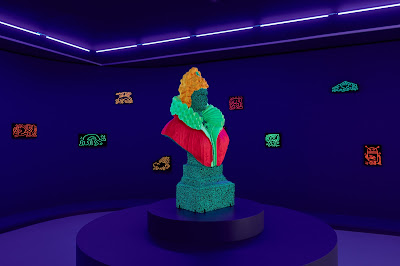 |
| Image courtesy of the NGV |
Melbourne's premier art gallery, the National Gallery of Victoria, has had some interesting exhibition mash-ups in recent years. From Warhol & Weiwei to Escher & Nendo, the NGV's curators have had fun contrasting different styles, techniques and eras.
Their latest big two-for-one exhibition, Basquiat/Haring: Crossing Lines is less about contrasting origins, since Jean-Michel Basquiat and Keith Haring were friends and both arose from the street art scene of 1980s New York.
 |
| Image courtesy of the NGV |
Their artistic styles, however, couldn't be more different. Basquiat was best known for his "primitivist" works, with raw lines and colours, often depicting black figures and painted on planks, doors, or canvas stretched across poles.
Haring's art ran more to tight cartoon-like frames featuring humanoid figures, interacting with vibrant backgrounds that commented on issues in the world around them.
 |
| Image courtesy of the NGV |
The exhibition is roughly chronological - the visitor enters through a faux-alley on which is projected film of Haring being arrested in the NYC subway after drawing on a blank advertising space, then rolls through the 1980s as both artists grow in stature, style and technique.
 |
| Image courtesy of the NGV |
Other than a darkened room filled with Day-Glo works once exhibited at a New York gallery, there's not much additional tinkering with the exhibition space - and that's all to the good. The artists' work is strong enough to speak for itself, and the contrasts and juxtapositions as you glance around the rooms are stimulating.
 |
| Image courtesy of the NGV |
Having said that, Basquiat's work has the edge in my eyes. I love its bold colours, its raw lines, the feeling of power shrouded in mystery that's exuded by the crowned figures he created. I could look at his larger works for hours, puzzling them out.
Neither artist is still with us - Basquiat died in 1988, Haring in 1990 - but their work lives boldly on.
Basquiat/Haring: Crossing Lines continues to 13 April 2020, at NGV International, 180 St Kilda Road, Melbourne, Australia. Tickets $30 for adults, $25 concession. Make bookings here.
No comments:
Post a Comment